Qualcomm Unveils Snapdragon X Elite featuring Oryon CPU cores that could give Intel, AMD and Apple CPUs a run for their money
Qualcomm's Snapdragon X Elite, with its new Oryon CPU core, poses a significant challenge to market stalwarts like Intel, AMD, and Apple, especially in power efficiency.
The new Adreno GPU, Hexagon NPU, and robust LPDDR5x memory integration aim to provide a well-rounded, high-performance system-on-chip (SoC) solution.
With a mid-2024 release, the Snapdragon X Elite aims to leverage partnerships with Microsoft, HP and Lenovo for a stronger market entry.

Snapdragon X Elite, Qualcomm’s magnum opus in its sisyphean endeavour to carve a market share in the PC market, was announced at Snapdragon Summit 2023. In the Android market, Qualcomm Snapdragon chips have retained their lead over the competition for many years. However, the PC market has been a rather difficult arena to battle in. Decades of evolution of the PC operating systems have ensured that the x86 architecture is what the PC segment is all about.
 Survey
SurveyIntel, as of 2023-Q2 holds 82.6 per cent of the overall x86 market share leaving AMD with 17.4 per cent as per the latest Mercury Research study. If we look at the broader segment of notebooks which also include ARM-based designs then Apple jumps into the fray with their M1 and M2 chips. Then we have Intel at 70 per cent, AMD at 17.6 per cent and ARM at 12.8 per cent, as per Counterpoint Research. Apple makes up 90 per cent of the ARM-based notebooks. That is all set to change with the introduction of the Snapdragon X Elite.
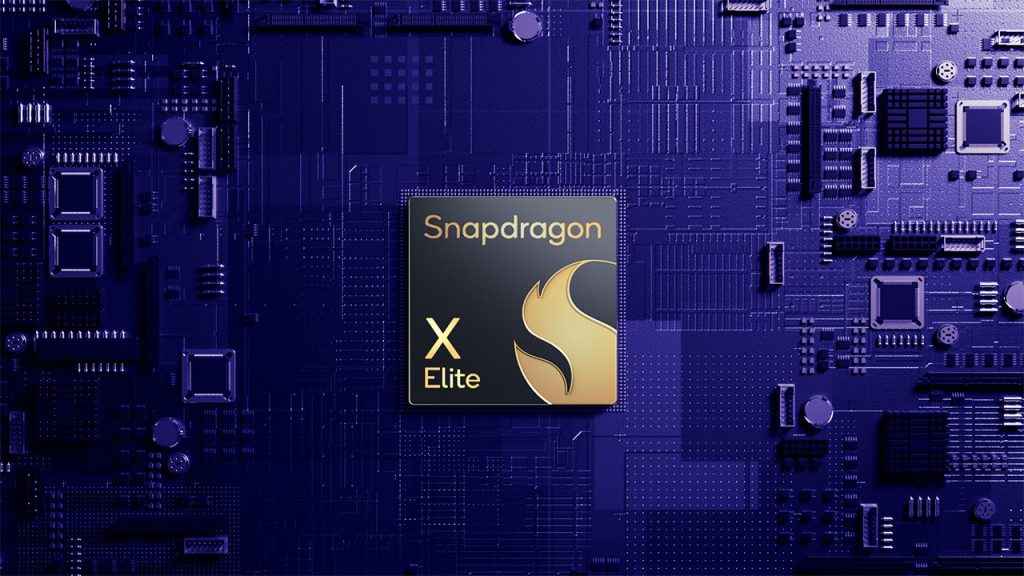
That being said, the Snapdragon X Elite isn’t Qualcomm’s first venture into the space. They started with the Snapdragon 835 and 850 based notebooks back in 2017. This was followed by the Snapdragon 7c platform, then came the 8c and 8cx platforms. These were all chips built for smartphones with improvements in terms of higher cache memory, wider memory bus, support for faster NVMe devices and additional improvements. At the heart of all these SoCs were Snapdragon Kryo CPU cores. Each iteration was but a simple incremental upgrade over the previous iteration and they were nowhere close to matching the prowess of the market leading chips from Intel. That changed with the acquisition of Nuvia Labs in 2021.
While NUVIA labs was a fledgling startup, it was led by folks who spent a good decade at ARM, Intel, Texas Instruments and Apple among other major tech companies. Notably, the CEO of Nuvia, Gerard Williams was the Chief CPU Architect at Apple. So the acquisition gave Qualcomm a much needed shot in the arm and helped improve their CPU roadmap which has finally led to the creation of the new Oryon CPU. The Oryon CPU cores are what set the new Snapdragon X Elite SoCs apart from the preceding compute platforms from Qualcomm. Let’s take a closer look at the Snapdragon X Elite, or as Qualcomm CEO Christiano Amon put it, the “new sheriff in town”.
Snapdragon X Elite: Homogenised again
The previous Snapdragon compute platforms from Qualcomm have all featured a heterogeneous architecture since they were based on ARM’s big.LITTLE architecture. With the Snapdragon X Elite, Qualcomm has opted for a homogeneous approach with 12 Oryon Cores. Most of the specifications of the Oryon cores are still under wraps but from what we know, there are three clusters of four cores each. Each core is capable of running at clock speeds going up to 3.8 GHz. However, there is a two-core Turbo profile allowing two of the best CPU cores to scale up to 4.3 GHz. While these clock speeds are far from what Intel’s new Meteor Lake chips are capable of, performance is not all about the clock speeds.
| Snapdragon X Elite Specifications | ||||
| Snapdragon X Elite | Snapdragon 8cx Gen 3 | Snapdragon 8cx Gen 2 | Snapdragon 8cx Gen 1 | |
| Performance Cores | 12x Oryon | 4x Cortex-X1 | 4x Cortex A76 | 4x Cortex A76 |
| Perf Core Clock | 3.8 GHz | 3.0 GHz | 3.15 GHz | 2.84 GHz |
| Perf Core Turbo Clock | 4.3 GHz (2 Cores) | NA | NA | NA |
| Efficiency Cores | NA | 4x Cortex A78 | 4x Cortex A55 | 4x Cortex A55 |
| Eff Core Clock | NA | 2.4 GHz | 1.8 GHz | 1.8 GHz |
| GPU | Adreno SD X Elite | Adreno 8cx Gen 3 | Adreno 690 | Adreno 680 |
| GPU Perf | 4.6 TFLOPS | ? | 2.1 TFLOPS | 1.8 TFLOPS |
| NPU | Hexagon | Hexagon | Hexagon 690 | Hexagon 690 |
| NPU Perf | 45 TOPS | 29 TOPS | 9 TOPS | 9 TOPS |
| Memory | 8 x 16-bit LPDDR5X-8533 | 8 x 16-bit LPDDR4X-4266 | 8 x 16-bit LPDDR4X-4266 | 8 x 16-bit LPDDR4X-4266 |
| Memory Bandwidth | 136 GBps | 86.3 GBps | 86.3 GBps | 86 GBps |
| Wi-Fi | Wi-Fi 7 | Wi-Fi 6E | Wi-Fi 6 | Wi-Fi 5 |
| Bluetooth | 5.4 | 5.1 | 5.1 | 5.0 |
| Modem | Snapdragon X65 | Snapdragon X65 | Snapdragon X24+X55 | Snapdragon X24+X55 |
| Process Node | TSMC N4P (Likely) | Samsung 5LPE | TSMC N7 | TSMC N7 |
Along with the Oryon Cores, we’ve got the Adreno SD X Elite GPU that is capable of churning out 4.6 TFLOPS and a Hexagon NPU capable of hitting 46 TOPS on INT4. More on these later. For the memory, the X Elite supports up to 8x 16-bit LPDDR5X-8533 NAND chips with a cumulative bandwidth of up to 136 GBps. And it comes with Wi-Fi 7, Bluetooth 5.4 and a Snapdragon X65 modem. All of this is made on a TSMC 4nm process node.
Snapdragon Oryon CPU: A leap of faith?
Like we mentioned before, the Oryon CPU core is a testament to Qualcomm’s acquisition of Nuvia in early 2021. This allowed Qualcomm to leverage the talent at Nuvia which had worked closely on the custom ARM cores that power the current Apple M1 and M2 SoCs. The homogeneous core architecture is not a radical departure from ARM’s heterogeneous designs but it is an interesting statement. The other major CPU designs have seen heterogeneous cores as a way to scale performance while not demanding a much higher power budget. So for Qualcomm to go the homogeneous way, does raise some eyebrows. Thankfully, the benchmarks that they shared at Snapdragon Summit do seem to justify this design choice.
The following benchmark information is shared by Qualcomm so until they’re verified by third-parties, take the following with a pinch of salt. Qualcomm claims that the new X Elite SoC powered by Oryon Cores are capable of beating the Apple M2 Max in Geekbench 6.2.1 by a significant margin in single-threaded benchmarks. The reference design Snapdragon X Elite scored a geomean of 3227 points opposed to the 2841 points that the Apple M2 Max (12 CPU Cores + 38 GPU Cores). This is the best Apple M2 Max CPU in existence right now. Apple also has another CPU called the M2 Ultra which is made by joining two M2 Max CPUs together. However, that wouldn’t be an apples-to-apples comparison.
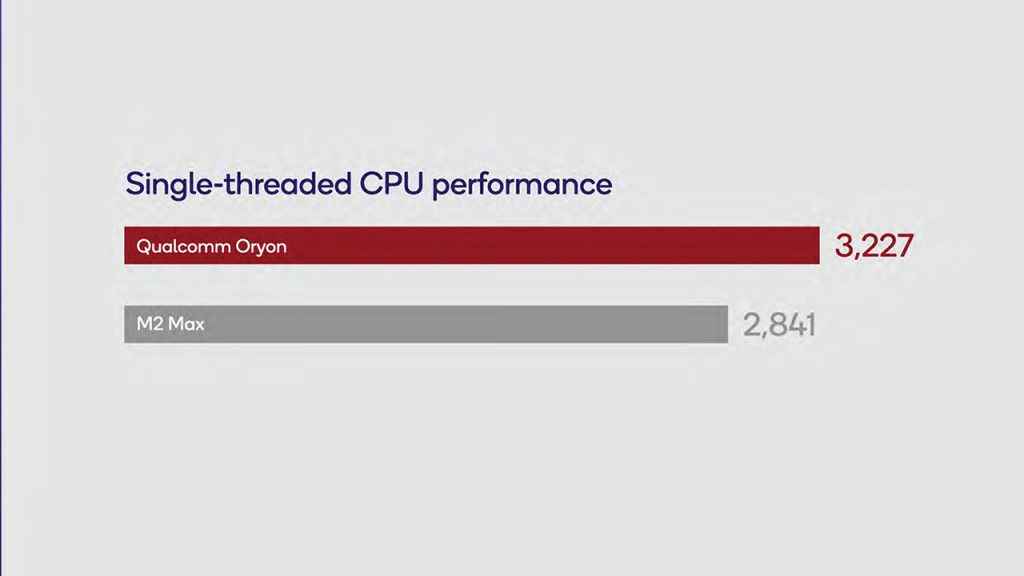
Qualcomm also claims that it doesn’t need to go all out. If it comes down to beating the M2 Max running at peak power levels, then the Snapdragon X Elite can supposedly beat the M2 Max while consuming 30 per cent less power. Remember that both SoCs, the Snapdragon X Elite and the Apple M2 Max, feature the exact same core counts so this statistic implies that the Snapdragon X Elite is more power-efficient than the Apple M2 Max.
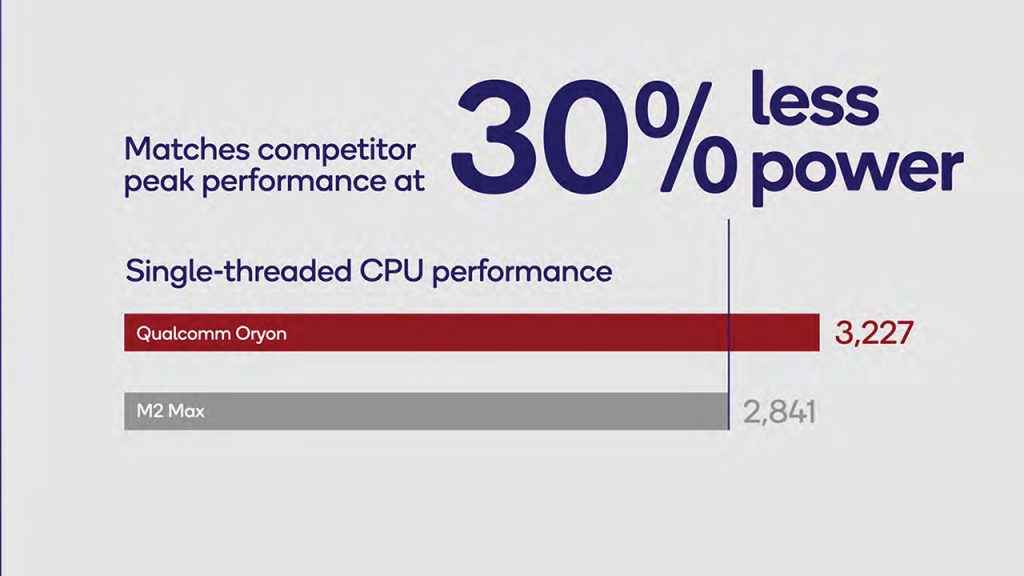
While ARM-based designs only make up a miniscule 12.8 per cent of the laptop market share, the real competitor is Intel. And Qualcomm claims that the Oryon Cores can beat the Intel Core i9-13980HX. Yet again, Qualcomm claims that they can beat the Intel CPU at 70 per cent less power. If true, this is huge.
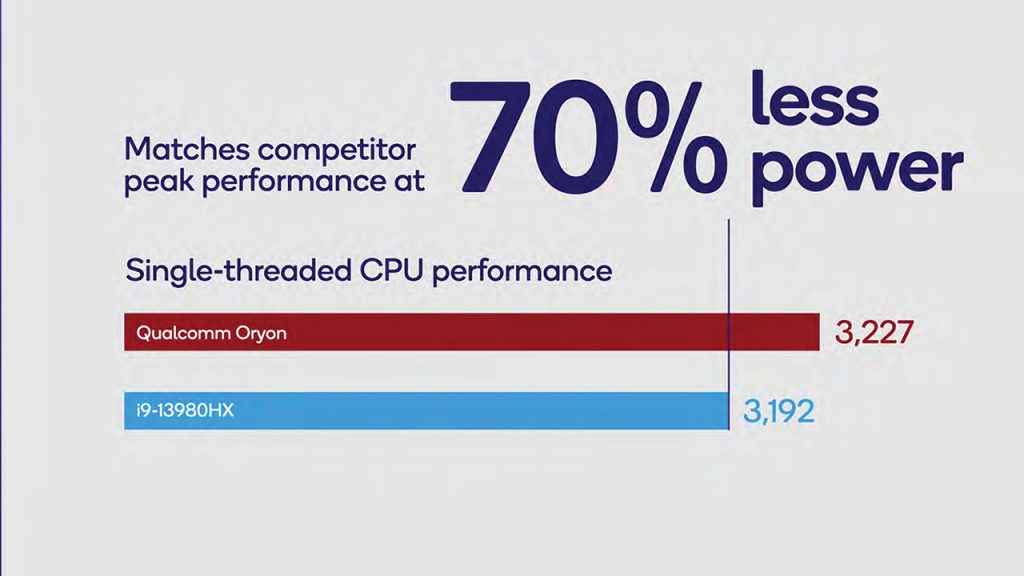
Qualcomm also had multi-threaded benchmarks for the more popular CPUs such as the Intel Core i7-1360P and the Core i7-1355U. The Snapdragon X Elite was shown to achieve twice the performance when running at the same power levels. And if the performance was to be matched, then the Snapdragon X Elite could do so while consuming 68 per cent less power.
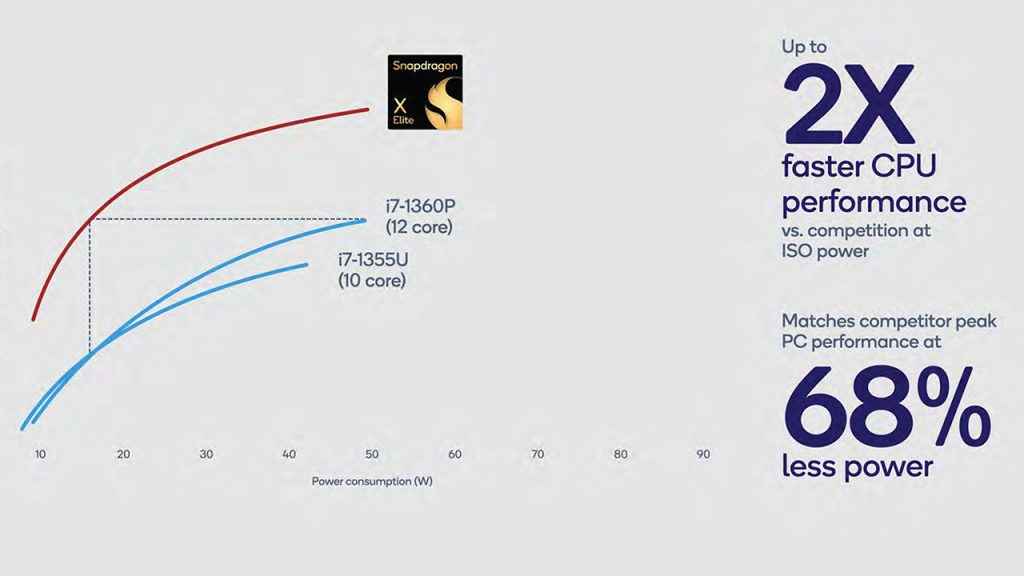
GPU: Powering visuals
The Snapdragon X Elite is equipped with the latest generation Adreno GPU, a DirectX 12-class GPU with ray tracing support. Although Qualcomm has been tight-lipped about the architectural details, the GPU’s prowess is evident, with a throughput of 4.6 TFLOPS. That’s more than twice as much as the Adreno GPU in the Snapdragon 8cx Gen 2 was capable of. We don’t have confirmation if both these numbers were FP32 benchmarks.
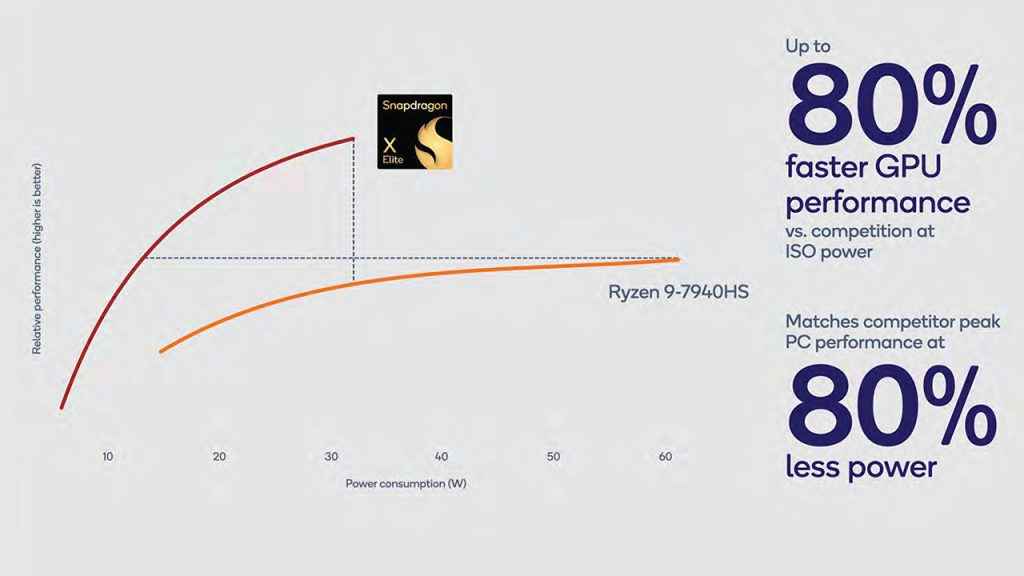
When compared to the integrated GPU within the Intel Core i7-13800H, the new Adreno GPU within the Snapdragon X Elite claims to get up to twice the GPU performance of the Intel Xe iGPU while at the same power levels. Currently, AMD has the better integrated GPU and Qualcomm shared that the Adreno GPU can attain 80 per cent faster performance while at the same power levels when compared with the AMD Radeon 780M that’s in the Ryzen 9 7940HS. In both comparisons, Qualcomm claims to beat the top-tier integrated GPUs. However, they did not share benchmarks going against the Apple M2 Max. So we could assume that Apple still has the upper hand in the integrated GPU side of things.
NPU: AI workloads
On the AI front, the Snapdragon X Elite boasts a revamped Hexagon Neural Processing Unit (NPU) envisioned to tackle the burgeoning demands of local AI model executions. This overhaul is expected to markedly outstrip the performance of the 8cx Gen 3’s NPU, promising a whopping 45 TOPS of performance. The NPU in the Snapdragon 8cx was capable of achieving 29 TOPS. So this is more than a 2x growth in performance gen-over-gen. The NPU is one of the biggest improvements and Qualcomm is working towards enabling local executions on large language models. In particular, most of the demos showcased were for Meta’s recently announced Llama 2 model which come in 7, 13, 33 and 65 Billion parameters. Of these, the 13 Billion parameter Llama 2 model is what Qualcomm is targeting.
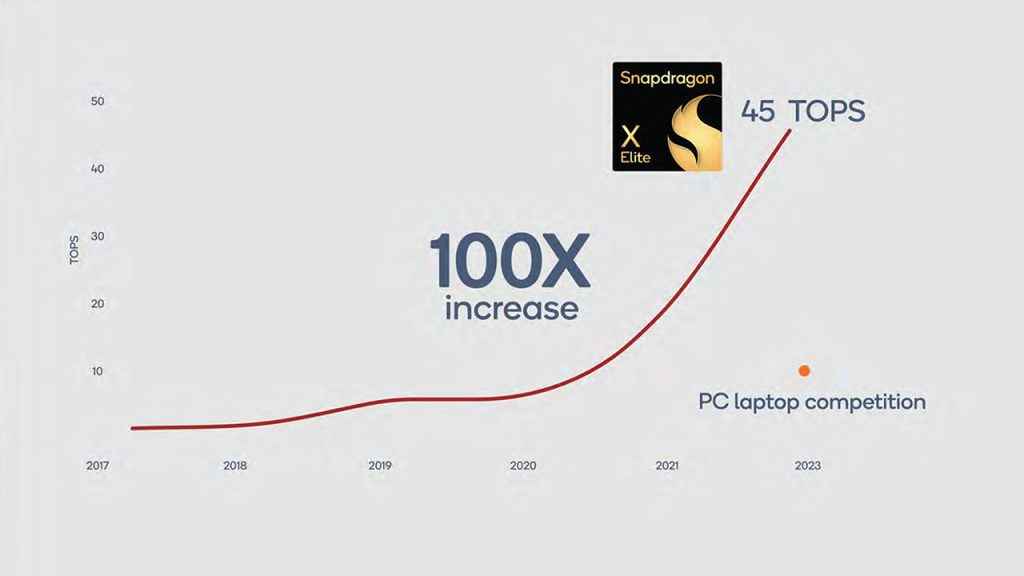
Qualcomm didn’t share any benchmark comparisons going up against the competition because the market yet doesn’t have enough SKUs. While AMD has had its very first SoC with an inbuilt Ryzen AI NPU already out in the market, there aren’t that many laptops featuring the new SoCs. And Intel is expected to launch their Meteor Lake mobile SoCs on December 14th. There isn’t a lot that you could do using an NPU on Windows-based systems. Windows Studio Effects is a new feature set that came out in March 2023 that has some neat features such as Background Blur, Eye Contact, Auto Framing and Voice Focus. These are AI-powered quality of life improvements which lend to better user experiences, most notably with teleconferencing software. All of these features have been a part of NVIDIA Broadcast ever since it launched back in 2020. However, you needed to have a supported NVIDIA GPU to make use of these features. Now, Microsoft has gone ahead and baked it into Windows so that any compatible hardware can use it. And in the case of SoCs, this workload is handled by the NPUs.
Memory configuration: Bridging the speed gap
A robust 128-bit LPDDR5x memory bus feeds the new Oryon CPU cores, showcasing a significant enhancement over the previous LPDDR4x supported by the 8cx chips. This upgrade catapults Qualcomm to par with contemporary PC chips from Intel and AMD in terms of memory technology, offering data rates as lofty as LPDDR5x-8533, a feat that places Qualcomm amongst the ranks of the fastest memory controllers in the market. Faster memory plays a significant role in the processing of AI workloads and the generative AI models featured in the new Snapdragon chips will require really fast RAM and lots of it.
Overall, the X Elite can support up to 64 GB of RAM spread across 8 channels. Each being 16-bit wide. With a peak transfer rate of 8533 MT/s this works out to be 136 GBps. We were also told that the total cache on the Snapdragon X Elite would be 42 MB. This would most certainly be a cumulative count of the L2 and L3 caches.
Snapdragon X Elite I/O capabilities
The Snapdragon X Elite exhibits a robust I/O portfolio, featuring PCIe 4.0 connectivity for NVMe storage and USB4 support, capable of driving up to three Type-C ports. The discrete Wi-Fi 7 and modem solutions underscore the flexibility that Qualcomm intends to offer OEMs, a distinctive trait that sets the Snapdragon X Elite apart.
Qualcomm will be pairing the FastConnect 7800 system with the Snapdragon X Elite which is a M.2 add-in card running over PCIe Gen 3. Together, you get support for 6 GHz, 5 GHz and 2.4 GHz Wi-Fi bands and Bluetooth 5.4 with LE.
For cellular, there is an external Snapdragon X65 5G modem which is also attached via an M.2 interface running over PCI Gen 3.
Beating the competition
It’s not an easy task. The new Snapdragon SoCs have to have unwavering app support. We saw announcements from Microsoft’s Pavan Davuluri who stated that all the Microsoft Office apps already run natively on ARM so that’s a huge win for use cases which involve normal office work. Microsoft also builds a significant chunk of the tools that developers use for building applications and several of those tools either run natively or run at par with some form of compatibility layer between the OS and the apps. Good user experience would dictate that more and more of these tools and apps should run natively so Qualcomm has plenty of time to get more ecosystem partners onboard by the launch date.

The Snapdragon X Elite sits on the vanguard of Qualcomm’s ambitious roadmap. The success of the Oryon CPU core could potentially lead to Snapdragon carving out a significant market share from not only Apple but also Intel and AMD. This certainly requires OEMs to adopt the new SoC and we saw positive comments from major OEMs such as Lenovo, HP and Microsoft.
The laptop market also requires SoCs to play along with the likes of NVIDIA and AMD whose discrete GPUs rule the market of gaming laptops which has been an ever growing segment. Also, we only saw limited benchmarks comparing the Snapdragon X Elite against the industry stalwarts. Also, a significant amount of use cases are services by instruction sets So only once we see the actual devices in the market can we comment on how successful the new Oryon cores will be.
Snapdragon X Elite availability: Mid-2024
With a tentative launch window of mid-2024, the Snapdragon X Elite is on the verge of making its foray into a market teeming with stalwarts like Intel’s Meteor Lake and AMD’s Phoenix chips. Meteor Lake will make landfall on December 14 whereas AMD’s Phoenix chips can be seen in the wild every now and then. Apple has been the first to respond to the Snapdragon X Elite’s threat with an event on the 30th of this month where it’s expected to announce new Macbooks, supposedly with better chips.
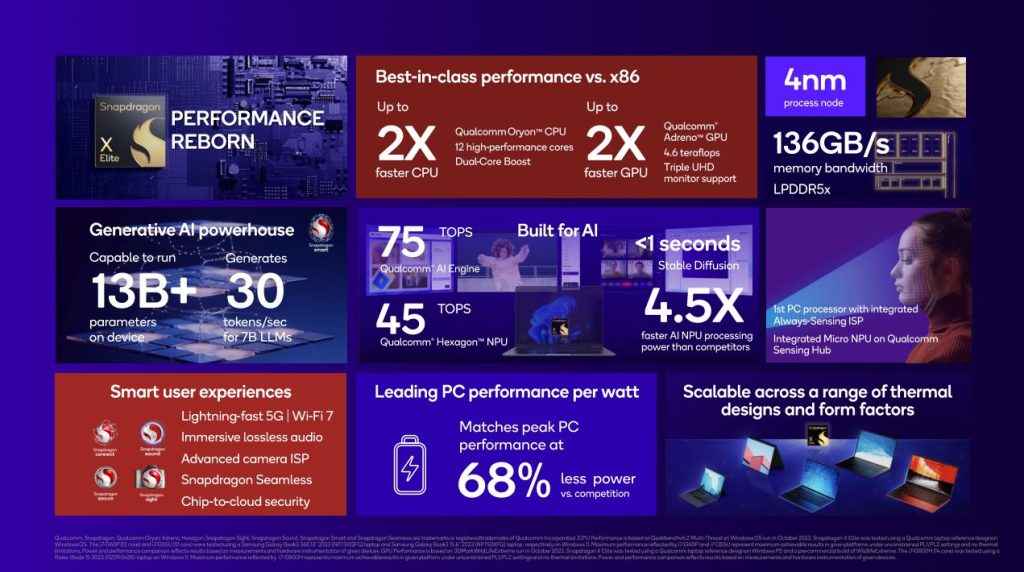
The Snapdragon X Elite, encapsulating a blend of interesting CPU design, robust memory configuration, and a host of other enticing features, stands as a testament to Qualcomm’s unwavering resolve to penetrate the Windows-on-Arm laptop market. Only time will tell how successful these new Oryon cores will be.
Mithun Mohandas
Mithun Mohandas is an Indian technology journalist with 14 years of experience covering consumer technology. He is currently employed at Digit in the capacity of a Managing Editor. Mithun has a background in Computer Engineering and was an active member of the IEEE during his college days. He has a penchant for digging deep into unravelling what makes a device tick. If there's a transistor in it, Mithun's probably going to rip it apart till he finds it. At Digit, he covers processors, graphics cards, storage media, displays and networking devices aside from anything developer related. As an avid PC gamer, he prefers RTS and FPS titles, and can be quite competitive in a race to the finish line. He only gets consoles for the exclusives. He can be seen playing Valorant, World of Tanks, HITMAN and the occasional Age of Empires or being the voice behind hundreds of Digit videos. View Full Profile